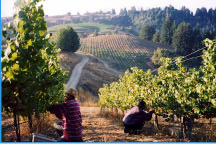Littorai Wines Age Gracefully
There is an old saw that has been floating around for years that California Pinot
Noir doesn’t age. This has been propagated in part because Americans have little
experience drinking aged Pinot Noir. The current vintages of Pinot Noir are often
made to be consumed within a year or two of release and wine enthusiasts are encouraged
to drink up before the next vintage. Upon release, Pinot Noir often
heads straight to restaurants where thirsty consumers quickly deplete them from
the wine lists. When have you seen any older vintages of American Pinot Noir on
a restaurant wine list?
The key to age ability for Pinot Noir is balance. If a wine doesn’t have balance to
begin with, it will never develop it, and the wine will age poorly because the
elements that are dominant become even more preponderant over time. Balance
does not refer to aromas or flavors, but rather the relative levels of acidity,
alcohol, tannin, and roundness that are felt in the mouth. A harmonious or wellbalanced
wine has all of these elements in equal amounts with no one element
dominant. Balance is a sign of quality and wines that are complete must have
impeccable balance.
The winemaking of Ted Lemon at Littorai is focused on balance and harmony. This
can allow the wines to improve and blossom with cellaring. Lemon’s winemaking
style avoids high alcohol levels and overripe flavors. Modest use of new oak is
used for aging the wines as an element of complexity, but never leads one to think
“oak” when tasting a Littorai wine. At Littorai, the goal is wines of elegance,
length, and finesse and wines which gain in complexity as they age. With polished
balance and proportion, the wines are uniquely suited to the dinner table at any
stage of their evolution. Although Lemon honors the Burgundian tradition, he does
not attempt to imitate Burgundy. He seeks the path between the excesses of many
modern California wines and the vacuousness of others.
Ted Lemon’s story is quite unique among California winemakers. The origins of
his interest in wine can be traced to a study-abroad program at the University of
Dijon in Burgundy while still a high school student. The director was so impressed
with Lemon, he offered him a job if ever decided to take up winemaking. After
graduating from Brown University, he was awarded a fellowship to return to
France in the fall of 1980 to study viticulture and enology. He apprenticed in several
famous Burgundy domaines including Dujac, Roumier, and Bruno Clair. When funds ran dry, he returned to the United States where he worked with Josh Jensen at Calera Winery.
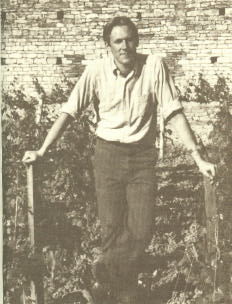
In 1982, while at Calera Winery, he was surprised by a phone
call from Jacques Seysses of Domaine Dujac who asked him,
“How would you like to make Meursault?” At Domaine Guy
Roulot in Meursault, one of the oldest and most traditional wineries
in Burgundy, Guy Roulot had died and his family was searching
for another winemaker. The Roulot family sought the advice
of Jacques Seysses. “Of all the apprentices I have had, and I
have had many,“ Jacques Seysses told Madame Roulot, “none
have been as bright and as capable as Ted Lemon. He has so
many fine qualities, but there are two problems. He is 25-yearsold,
and he is American.” Although Madame’s first reaction was
“impossible,” after consulting with Aubert de Villaine, Patrick
Bize, and others, she offered to make him the first (and to this
day, the only) American winemaker and vineyard manager in
Burgundy’s history. Lemon arrived at Domaine Roulot in 1983
(photo right).
Because lemon spoke French fluently, he was able to assimilate
and overcome the initial surprise and skepticism of the village
people. He said, “At first I had to prove myself physically to the cellar and field help. I had to prune as
quickly, drive a tractor as well, and work as hard as they could. And I had to prove to Madame Roulot,
who was so devoted to Guy, that I could keep up the reputation of his wines.” Lemon made very good
wines and quickly became accepted by the locals.
After two years at Domaine Roulot, he was lured back to the United States by a French family that had
purchased a vineyard on Howell Mountain above the Napa Valley. Their intent was to produce a
French-style Chardonnay in California. The land here had been first planted in 1877 with vines from
the Medoc region of France. Jean Adolphe Brun and W. J. Chaix were the original French owners and
they built the Howell Mountain Winery on the property in 1866. It became Chateau Woltner in the
mid-1980s and it was here, in 1985, that Lemon oversaw renovations of the aging winery and became
the vineyard manager as well as winemaker. Chateau Woltner’s Chardonnays soon became a favorite
among American wine connoisseurs.
With his winemaking skills honed and assured, Lemon and his wife Heidi founded Littorai in 1993. He
had spent a summer with his wife driving up and down the Pacific Coast tasting local wines and learning
about the soil and history of the local vineyards. Lemon had a firm belief in terroir inspired by his
years in France. According to Lemon, “I believe soil is of major importance in a wine’s character. It’s
clear there are tremendous differences between wines made from vineyards right next to each other
even if they are vinified and treated exactly the same way.” Finally, Lemon settled on sourcing his
grapes from vineyards in western Sonoma and western Mendocino counties. He believed the finest
Pinot Noir and Chardonnay were grown along the true coastal zone of the continent. He was convinced
that the geology and mesoclimates of the extreme western portion of the continent north of San
Francisco were diverse enough to create a series of unique terroirs, each with its own characteristics.
He named his new venture Littorai which is a pleural noun formed from the Latin word litor-, which
means the coasts. The word Littorai, with its reference to geography, reminds us that wine, the noblest
agricultural product, arises from the weave of place (vineyard), time (vintage), and man.

Since the beginning, Lemon has sourced his grapes from independent growers and most on a “by-theacre”
basis Littorai was the first modern California winery to create a “by-the-acre” contract for
grapes. In these contracts, growers are paid for the quality of what they grow, not the quantity, The
first contract was written in 1993 for One Acre Vineyard Pinot Noir in Anderson Valley. Such contracts
have now become the norm for the greatest vineyards in California.
Lemon closely supervises all aspects of vineyard management: pruning, composting, irrigation and
crop yields. In 2003, 40% of Littorai’s producing acreage was estate grown (either under ownership or
long term lease) and this percentage will increase in time. Beginning in 2003, over half of Littorai’s
producing acreage is farmed using biodynamic and agro-ecological methods. Lemon has planted 3
acres of Pinot Noir behind his home in the Sebastopol hills (Dijon 667, 777 and California heritage
selections) and has plans to plant 8 more. His first vintage from his home vineyard will be 2007.
Lemon is a true winegrower, in that he is intimately involved in the entire winemaking process from
planting and managing vines to corking and labeling bottles.
As Lemon finds vineyards which have exciting potential, he plans to add them to the family and make
them vineyard designates if they are truly unique. If he finds nothing new to excite him, he will simply
not grow. By the same token, if he is dissatisfied with the quality of fruit from a given vineyard in a
certain year, he simply will not produce it. Called declassification, it is a practice widely accepted and
practiced in France. As Ted says, “This philosophy requires that our clients understand, as we do, that
fine wine is not a commodity. We cannot simply invent more of it to satisfy demand. Indeed, that is
what distinguishes it from its less expensive brethren.” In 2005, there were 924 cases of vineyard designate
Pinot Noir and 720 cases of appellation Pinot Noir. Chardonnay production was 675 cases. The
2006 vintage was more giving and it is anticipated that there will be a total of 4,500 cases produced.
Lemon does not own a winery, but manages the Black-Sears Winery on Howell Mountain in Angwin,
Napa Valley. At this shared facility, he oversees the making of wines for Howell Mountain Vineyards,
The Black Sears Estate, Reverie, and Littorai. He plans to eventually build his own winery on his 30-
acre estate in Sebastopol which will put him closer to his vineyard sources in Sonoma and Mendocino.
Lemon is beginning to build a legacy of younger winemakers who have apprenticed under him. These
include the current winemaker at Saintsbury in Carneros, Jerome Chery, as well as Scott Wright of
Scott Paul Wines in Oregon and Sam Tannahill of A to Z wines and Archery Summit also in Oregon.
Doug Wisor, the head winemaker at Craggy Range, was one of Lemon’s protégés prior to his untimely
death.
The winemaking style at Littorai employs minimal intervention, long lees contact, and gentle handling
of the fruit and wine at all times. Pumps and filtration are avoided as much as possible. All of the
Chardonnays are barrel fermented. After a cold soak, the Pinot Noirs are fermented in traditional
open-top fermenters containing from 800 to 1500 gallons. At least some proportion of whole clusters
are utilized as dictated by the vintage. Punch down is by hand. All of the wines undergo native yeast
fermentation and complete malolactic fermentation, as long as nature does not dictate otherwise.
Aging is done in 30-50% new oak with medium toast for 16-18 months. I think patience is the key word
here, as Lemon is a patient winemaker who works with the juice at hand, an artist guided by his taste
more than science who avoids using new technology only for its own sake.
Ted is a life-long winemaker passionately committed to his craft. He has not come into wine as a
second career and this fact is essential to understanding Littorai. Littorai produces wines which adhere
to a personal and passionate esthetic sensibility. Lemon is not motivated by competition, ratings
or trends, or by the lure of publicity. He does not submit samples for scoring. Basically, his wines
speak for themselves. His latest newsletter had this quote from Max Leglise at the top: “Good wines
need no press secretary.”
I recently had the distinct honor of interviewing Ted Lemon for a podcast to be broadcast on Grape
Radio (www.graperadio.com) in the near future. I enjoyed meeting his family (3 children all under 10
years of age) and his lovely wife, Heidi (she runs the business side of Littorai). To commemorate this
event, I sat down with the crew from Grape Radio (Jay Selman, Brian Clark, and Eric Anderson) and
tasted through several older vintages of Littorai Pinot Noirs. I think you will be able to acquire a feel
for our enthusiasm for these wines in the podcast as well as in my tasting notes that follow. Without
exception, the wines had all aged extremely well and exhibited the lovely bouquets of Pinot Noir that
can only come with aging: barnyard, dark chocolate, tobacco, exotic woods, and mushrooms. Every
wine was balanced, understated (power with velvety softness), and had a certain Burgundian sensibility
(good acid structure). The terroir really came through and individual vineyard differences were
quite apparent. There was consistent excellence from vintage to vintage that was impressive. Not a
bad wine in the lineup R.I.P for the old saw about a perceived lack of age ability of California Pinot Noirs.
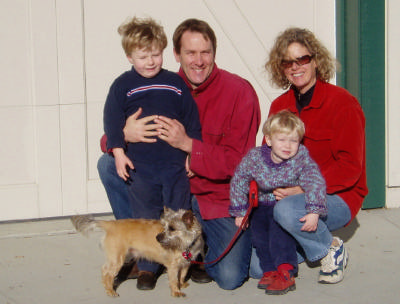
Littorai Tasting January 29, 2007
2004 Littorai Mays Canyon Russian River Valley Chardonnay
14.2% alc.. Brian’s favorite wine! Lemon says, “Great Chardonnay is one of the rarest and most exciting wines in
the world.” By the way, Lemon also remarked in his recent newsletter that the current 2005 vintage
may be the greatest for Chardonnay he has ever seen in 24 years of making it - equal or better than
1986, 1994, and 1995 in California and 1982, 1986, and 1996 in Burgundy!
·
Very Meursault-like.
Beautifully balanced with an appealing mineral and citrus aftertaste. No buttery oak onslaught here. A
charming wine that was drinking even better with more richness from the opened bottle eight hours later.
2000 Littorai Hirsch Vineyard Sonoma Coast Pinot Noir
14.2% alc.. Littorai was one
of the first and most important purchasers of the famed Hirsch Vineyard and came to Hirsch at the
same time as Burt Williams and Steve Kistler in 1994. Most producers who source fruit from Hirsch
Vineyard do so from different blocks that are scattered over the hilltops and hillsides on the 1,100 acre
Hirsch property. This arrangement means that no Hirsch Vineyard wines from different producers can
be tasted and contrasted in the context of a proper terroir tasting in the Burgundian sense of the word.
·
A typical Hirsch with a big and expressive nose of dark stone
fruits, exotic spices, and cinnamon. Big-boned and well-muscled, it
is nevertheless, beautifully balanced and composed. The tannic
edge to the finish will soften with further cellaring.
1999 Littorai One Acre Vineyard Anderson Valley Pinot Noir
14.4% alc.. Alas, One Acre Vineyard had to be replanted and the 2004 vintage
was the last for several years.
·
This Pinot is a showoff.
The alluring aromas of dark cherries, barnyard and dark chocolate lead you to plenty of dark Pinot extract
in the mouth. The mid palate flavors are big and powerful, yet the wine finishes on a lengthy and delicate
note of cherry fruit. This is truly a complete wine with everything in symphony. This wine makes the hair
stand up on the back of your neck.
1999 Littorai Theiriot Vineyard Sonoma Coast Pinot Noir
14.3% alc.. Thieriot is my perennial favorite and the
2001 Littorai Theiriot Vineyard Pinot Noir was my Littorai epiphany several years ago.
·
A big, rich nose followed by a
panoply of dark stone fruits, spice and a little tobacco. Reminds me of a wine from Nuits-St-George. This
winner has a very plush mouth feel. Still a Lolita. Thieriot Pinots are like a Prom Queen: she smells great,
is beautiful and is someone you could dance with all night.
1998 Littorai Savoy Vineyard Anderson Valley Pinot Noir
13.8% alc.. Littorai was the first winery to make a vineyard
designate from Savoy Vineyard. Now there are multiple producers who purchase fruit from this
special site. Lemon was also the first producer to clearly demonstrate the potential for fine Anderson
Valley Pinot Noir beginning in 1993. He found that world-class production could be achieved here
with low yields, proper clones, vertical trellising, leaf removal, and other farming techniques.
·
Very light in color and body,
this wine blossomed beautifully with air time with more nose and punch than the ‘96. Soft and sweet red
fruits are accompanied by dried herbs. The wine finished nicely with a hint of oak and cashmere tannins.
Savoy reminds me of the shy and demure young lady in the corner, who, when she takes her glasses off and lets her hair down, everyone goes wow!
1997 Littorai Hirsch Vineyard Sonoma Coast Pinot Noir
14.1% alc..
·
The Hirsch Vineyard Pinot Noirs
are the biggest, boldest, earthiest, and most sinewy and tannic of the Littorai lineup. This 1997 Pinot still
has perceptible tannins on the back end but they are dusty now.
There is still plenty of flashy , ripe fruits with a definite underlying
earthiness smokiness and minerality. I think this wine could go another
10 years.
1997 Littorai Theiriot Vineyard Sonoma Coast Pinot Noir
13.3% alc..
·
This wine is showing a touch of
yellowing around the rim. There are sweet dark fruits here highlighted by pepper, wet leaves and anise.
The tannins have softened considerably and the finish is very clean with brisk acidity.
1996 Littorai Savoy Vineyard Anderson Valley Pinot Noir
14.3% alc..
·
The two Savoys tasted here
were lighter, more austere with a more notable acid spine than the wines from other vineyards. With
swirling, the shy nose opened to bright and rich raisins, currents and exotic woods. A small touch of herbs
highlighted the back end.
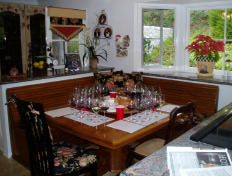
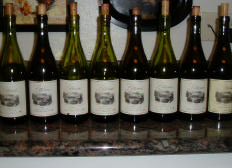
Littorai wines are sold only through a mailing list. As a testament to their quality, they are on the wine
lists of America’s most prestigious restaurants. The website is www.littorai.com and the phone is 707-
823-9589. The 2005 Pinot Noir releases include: Sonoma Coast and Les Larmes Anderson Valley (both
$42), Savoy Vineyard Anderson Valley($60), Hirsch Vineyard Sonoma Coast ($65), Mays Canyon
Vineyard Russian River Valley ($65), Cerise Vineyard Anderson Valley ($65), Roman Vineyard Anderson
Valley ($65), Thieriot Vineyard Sonoma Coast ($70), The Haven Sonoma Coast($75), and Summa
Vineyard Sonoma Coast ($80). The three Chardonnays include Charles Heintz Vineyard Sonoma
Coast, Mays Canyon Vineyard, and Thieriot Vineyard (all $60). Older vintages rarely come up for
auction, but Littorai periodically releases previous vintages from the winery’s library, a practice that is
rarely seen in today’s financial climate where wineries infrequently hold back significant amounts of
previous vintages.






